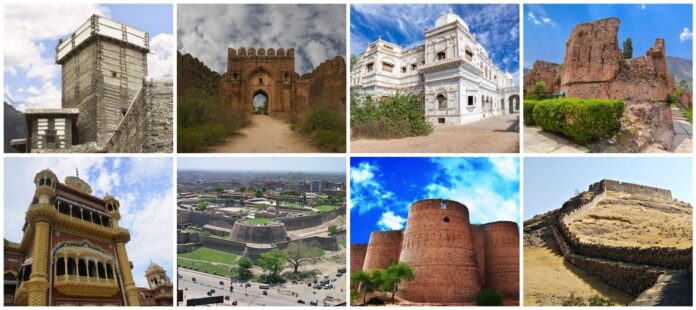The forts in Pakistan are architectural wonders that retain their dignity, regardless of whether they are regarded as historical sites or archaeological reserves. Pakistan’s top ten forts are essential to the country’s placement among the world’s top tourist destinations. We’re going to take you on a humorous adventure to discover the infotainment concealed within Pakistan’s forts.
The Royal Fort of Lahore
Located in the western part of the walled city, Royal Fort is one of Pakistan’s most prominent forts and the identity of the capital city of Lahore. Its common name, Shahi Qila, translates to “royal fort.” The Mughal emperor Akbar is credited with rebuilding the fort in the seventeenth century, resulting in the current structure. Its development was influenced by Sikh, British, and Mughal regulations. Its overall area exceeds 20 hectares. Let’s discuss its current configuration, which consists of two gates. The first is the Emperor Aurangzeb’s Alamgiri Gate, which opens into the Badshahi Mosque. The second is Emperor Akbar’s Maseeti or Masjidi Gate, which opens towards the Masti Gate region of Lahore. The second gate is not used for crossing and is instead used as the main entrance, Alamgiri Gate.
The fort’s three most well-known sections are its highlights, despite the impressive design throughout. The Sheesh Mehal is a palace of mirrors with a ceiling that is still glitzy today. It is constructed of crystals and exquisite white marble. Additionally, the fort features eleven gates: Sohail Gate, Khwas Khani, Tulla Mori, Sar, Shah Chandwali, Shishi, Kabuli, Langar Khani, Talaqi, Kashmiri, Khwas Khani, Gatali, and Pipalwala Gate. Emperors would convene in Dewan-e-Khas to discuss concerns of state. Dewan-e-Am, on the other hand, was devoted to the public, who addressed emperors about social matters.
The magnificent architectural legacy of the Mughals is reflected in this monument. In 1981, Lahore Fort was designated as a World Heritage Site by UNESCO.
Fort Rohtas
One of Pakistan’s best forts, Rohtas Fort is situated in Dina town, close to Jhelum metropolis. Between 1540 and 1547 AD, King Sher Shah Suri constructed it. The real reason this fort was built was to weaken the power of the Gakhars, a native tribe in Potohar. The King longed to save his throne and intended to utilise the Rohtas Fort in battle. In terms of architecture, the fort is 5.2 km in size and has lovely hills all around it. There is exquisite ashlar stone work on the majority of its surfaces. Sohail, Shah Chandwali, Langer Kahni, Kabuli, Shosho, Talarqi, KKhwas Khani, Gatali, Pipalwala, Mor, and Sar Gate are the eleven gates of Rohtas Fort.
Altit Fort
Altit Fort in the Hunza Valley is renowned for offering a bird’s-eye perspective of the once-famous Shahra-e-Resham. Karimabad is where it’s situated. The fort is regarded as the oldest landmark in Gilgit-Baltistan, having been built about 900 years ago. The famed walkways, apricot and orchard trees, and royal garden are only a few of the many features that enhance Altit Fort’s natural splendour. Since 2007, Altit Fort has been a popular tourist destination. This fort had severe structural problems before, but the Agha Khan Trust worked with the governments of Japan and Norway to rebuild it and make it one of the valley’s top tourist destinations.
Baltit Fort
Another well-known fort is Baltit Fort, which is situated in the Gilgit-Baltistan region’s Hunza Valley. It is well recognised that the Baltit Fort has historical value. Baltit Fort is one of the nation’s oldest monuments, having been built 700 years ago.Over the ages, the design of this fort has undergone numerous changes and revisions. When the princess of Baltistan married the local prince in the sixteenth century, this fort was given to her as a dowry. Considering this fort as an amazing tourist destination, it is a stone and wood construction constructed next to the Ultar Sar glacier. From up here, you can see the entire city of Karimabad.
Derawar Fort
One of Pakistan’s forts that is still in fine shape today is Derawar Fort. This fort, which is located in the city of Bahawalpur 48 kilometres from Dera Nawab Sahib, served as the royal family’s home. The largest fort in Pakistan is Derawar Fort, which has a circumference of 1,500 metres. Its walls reach a height of thirty metres. Built by the Hindu Rajput Rai Jajja Bhati of Jaisalmer in the ninth century AD, the fort was originally known as Dera Rawar Fort before changing its name to Derawar.
Fort Ranikot
In the Sindhi district of Jamshoro, Pakistan where Ranikot Fort is located, the Kirthar mountain range is well-known. Because of its roughly 26-kilometer circumference, it holds the title of largest fort in the world. Ranikot Fort is renowned as Sindh’s wall. In 1812, Mir Karam Ali Khan Talpur and his brother Mir Murad Ali rebuilt it because of structural instability. A stunning building with a well-planned layout demonstrates the skill of that era’s masterminds.
Red Fort
Another wonderful archaeological site with picturesque views is a red fort in Kashmir, Pakistan which is located next to the Neelum River. Muzaffarabad Fort is another name for Red Fort. Because it was constructed in 1646, it is renowned as one of Pakistan’s oldest forts. The magnificent building is a testament to the skill of those bygone eras of builders. Red Fort’s three gorgeously Neelum River-surrounded sides give it the appearance of an iconic piece of landscape architecture.
Bala Hisar Fort
Located in Peshawar, Pakistan, the Bala Hisar fort is one of Khyber Pakhtunkhwa’s top tourist destinations. At the beginning of the 1800s, Afghan kings lived there. Bala Hisar translates to “the elevated high fort.” Visitors are greatly amused by its artistic vision of magnificent structures.
Mehal Noor
During the British Raj, the Noor Mehal was the home of the Nawab of the princely state of Bahawalpur. Its regal architecture perfectly captures the elegance of a palace. Noor Mehal is linked to a momentous historical event. Nawab Subah Sadiq IV erected the palace in 1872 and dedicated it to his wife. She stayed in this fort for one night, and after learning that there was a cemetery nearby with her wife, she left the following day.
Sadiq Garh Palace
The stunning Sadiq Garh Palace in Pakistan should also be highlighted when discussing Pakistan’s best forts. This historic and magnificent mansion is located in the Dera Nawab Sahib district of Bahawalpur, Punjab province. Nawab Sadiq Muhammad Khan, the King of Bahawalpur, ordered the construction of Sadiq Garh Palace in 1882. In just ten years, engineers in Bahawalpur created this stunning work of art. The exquisite central dome and every corner bastion accentuate the elegance. The Sadiq Garh palace is enclosed by a huge wall and lush grass.



